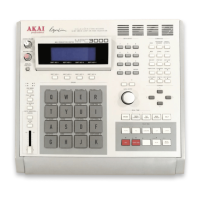
Do you have a question about the Akai MPC 3000 and is the answer not in the manual?
| Polyphony | 32 voices |
|---|---|
| Sampling Rate | 44.1 kHz |
| Sampling Resolution | 16-bit |
| Memory | 2MB (expandable to 16MB) |
| Pads | 16 velocity and pressure sensitive pads |
| Sequencer | Yes |
| Sequencer Resolution | 96 PPQ |
| Storage | 3.5" floppy disk drive |
| MIDI | In, Out, Thru |
| Display | LCD |
| Outputs | stereo output |
| Inputs | 2 x 1/4" inputs |
Summary of the MPC3000's evolution and user-centric design philosophy.
Overview of the MPC3000's general and sound generation capabilities.
Highlights key changes and improvements over the MPC60 model.
Diagram and explanation for connecting the MPC3000 to MIDI devices.
Explanation of the Play/Record screen, cursor, and data fields.
Details on using the numeric keypad and data entry controls.
Explanation of the functions assigned to the four soft keys.
How to access context-sensitive help for data fields.
Clarifies fundamental MPC3000 terminology for user understanding.
Instructions for loading sounds and programs from disk and playing them.
Guide to choosing and assigning sounds within program sets.
Details on real-time parameter control for sounds.
Explanation of the 16 Levels function for parameter variation.
Describes the structure of sequences, tracks, and timing resolution.
Details the primary operational screen and its modes.
Explains how to fix timing issues and apply swing.
Covers tempo settings, sources, and display modes.
Instructions for implementing tempo variations within sequences.
Describes automated entry and exit from record modes.
Procedure for resetting system parameters to factory defaults.
Details functions for erasing notes and initializing sequences.
Provides access to various sequence editing functions.
How to view and modify time signatures within sequences.
Procedure for adding empty bars to a sequence.
Method for copying events between tracks and sequences.
Adjusting the timing of multiple notes simultaneously.
Editing velocity, duration, and note number for multiple notes.
Detailed editing of individual events within a sequence.
Explains the advantages and structure of Song mode.
Describes how to enter and navigate Song mode.
Method to convert song structures into editable sequences.
Definition and structure of programs as sound sets.
Guide to choosing programs and assigning sounds to notes.
Editing sound envelope, velocity, and tuning parameters.
Details on the lowpass filter and its envelope generator.
Adjusting volume and pan for stereo output.
Routing sounds to individual outputs and effects.
Configuring mixer data sources and recording mix changes.
Settings for internal delay effects.
Instructions for recording new audio samples into the MPC3000.
Modifying sound parameters and sample data.
Procedures for managing sounds in memory.
Using external audio signals to trigger sounds.
Explanation of file types and disk operations.
General procedures for saving various data types.
How to save individual sequences to disk.
Saving all sequences and songs together.
How to save single sounds to disk.
Saving a program and its associated sounds.
Saving all programs and their associated sounds.
Saving system-wide configuration settings.
Managing files on disk.
Instructions for loading sequences from disk.
Loading older MPC60 files and conversion.
Loading all sequences and songs from disk.
Instructions for loading single sounds from disk.
Loading programs and their associated sounds.
Loading all programs and their associated sounds.
Loading system-wide configuration settings.
Reading sample files from compatible external media.
Procedure for preparing disks for use with MPC3000.
Connecting and managing external hard drives.
How to sync with external MIDI clock sources.
Procedures for syncing with SMPTE timecode.
Syncing with MIDI Time Code signals.
Using FSK24 for tape sync.
Syncing to external 1/4-note click sources.
Mapping MPC3000 pads to MIDI note numbers.
Configuring MIDI routing and controller assignments.
Filtering incoming MIDI events for sound generator and sequencer.
Function to send MIDI Note Off messages to clear stuck notes.
Reference charts for MIDI communication capabilities.
Detailed hardware and software specifications of the MPC3000.
Common issues and their solutions.
Detailed breakdown of data stored in different file types.
Information about optional hardware upgrades.
Details on the SMPTE sync hardware option.
Instructions for upgrading the MPC3000's memory.
Description of the video output hardware option.